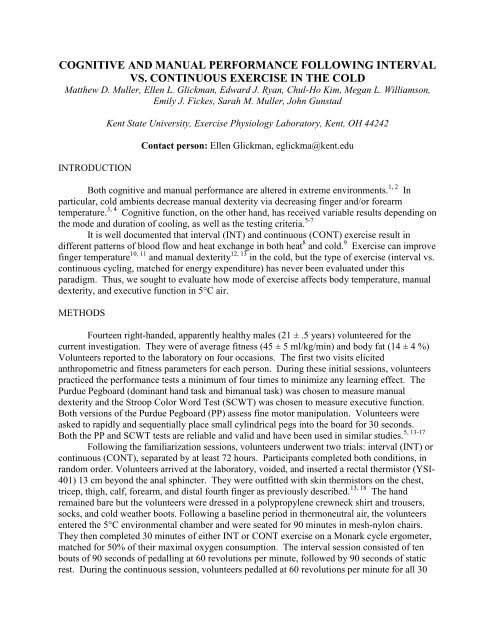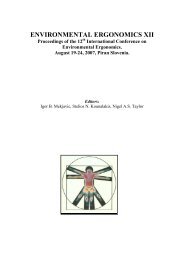Matthew D. Muller.pdf
Matthew D. Muller.pdf
Matthew D. Muller.pdf
You also want an ePaper? Increase the reach of your titles
YUMPU automatically turns print PDFs into web optimized ePapers that Google loves.
COGNITIVE AND MANUAL PERFORMANCE FOLLOWING INTERVAL<br />
VS. CONTINUOUS EXERCISE IN THE COLD<br />
<strong>Matthew</strong> D. <strong>Muller</strong>, Ellen L. Glickman, Edward J. Ryan, Chul-Ho Kim, Megan L. Williamson,<br />
Emily J. Fickes, Sarah M. <strong>Muller</strong>, John Gunstad<br />
INTRODUCTION<br />
Kent State University, Exercise Physiology Laboratory, Kent, OH 44242<br />
Contact person: Ellen Glickman, eglickma@kent.edu<br />
Both cognitive and manual performance are altered in extreme environments. 1, 2 In<br />
particular, cold ambients decrease manual dexterity via decreasing finger and/or forearm<br />
temperature. 3, 4 Cognitive function, on the other hand, has received variable results depending on<br />
the mode and duration of cooling, as well as the testing criteria. 5-7<br />
It is well documented that interval (INT) and continuous (CONT) exercise result in<br />
different patterns of blood flow and heat exchange in both heat 8 and cold. 9 Exercise can improve<br />
finger temperature 10, 11 and manual dexterity 12, 13 in the cold, but the type of exercise (interval vs.<br />
continuous cycling, matched for energy expenditure) has never been evaluated under this<br />
paradigm. Thus, we sought to evaluate how mode of exercise affects body temperature, manual<br />
dexterity, and executive function in 5°C air.<br />
METHODS<br />
Fourteen right-handed, apparently healthy males (21 ± .5 years) volunteered for the<br />
current investigation. They were of average fitness (45 ± 5 ml/kg/min) and body fat (14 ± 4 %)<br />
Volunteers reported to the laboratory on four occasions. The first two visits elicited<br />
anthropometric and fitness parameters for each person. During these initial sessions, volunteers<br />
practiced the performance tests a minimum of four times to minimize any learning effect. The<br />
Purdue Pegboard (dominant hand task and bimanual task) was chosen to measure manual<br />
dexterity and the Stroop Color Word Test (SCWT) was chosen to measure executive function.<br />
Both versions of the Purdue Pegboard (PP) assess fine motor manipulation. Volunteers were<br />
asked to rapidly and sequentially place small cylindrical pegs into the board for 30 seconds.<br />
Both the PP and SCWT tests are reliable and valid and have been used in similar studies.<br />
5, 13-17<br />
Following the familiarization sessions, volunteers underwent two trials: interval (INT) or<br />
continuous (CONT), separated by at least 72 hours. Participants completed both conditions, in<br />
random order. Volunteers arrived at the laboratory, voided, and inserted a rectal thermistor (YSI-<br />
401) 13 cm beyond the anal sphincter. They were outfitted with skin thermistors on the chest,<br />
tricep, thigh, calf, forearm, and distal fourth finger as previously described. 13, 18 The hand<br />
remained bare but the volunteers were dressed in a polypropylene crewneck shirt and trousers,<br />
socks, and cold weather boots. Following a baseline period in thermoneutral air, the volunteers<br />
entered the 5°C environmental chamber and were seated for 90 minutes in mesh-nylon chairs.<br />
They then completed 30 minutes of either INT or CONT exercise on a Monark cycle ergometer,<br />
matched for 50% of their maximal oxygen consumption. The interval session consisted of ten<br />
bouts of 90 seconds of pedalling at 60 revolutions per minute, followed by 90 seconds of static<br />
rest. During the continuous session, volunteers pedalled at 60 revolutions per minute for all 30
minutes. To ensure equal caloric expenditure between conditions, expired air samples were<br />
assessed. Following the exercise bout, volunteers were seated for the remaining 60 minutes. The<br />
details of the methodology and data collection are listed below.<br />
RESULTS<br />
A 2 (condition) by 10 (time) repeated measures analysis of variance was also conducted<br />
for the bimanual PP task. There was a strong trend toward significance for condition (p=.057) as<br />
well as a significant main effect for time (p=.000) and a significant condition by time interaction<br />
(p=.006). Subsequent post-hoc analysis via paired samples t-tests revealed significant<br />
performance differences following interval and continuous exercise. In particular, statistical<br />
significance was achieved at the following time points: REC-1 (p=.002), REC-2 (p=.018), and<br />
REC-4 (p=.007). A trend towards significance was noted at REC-3 (p=.132).<br />
A 2 (condition) by 10 (time) repeated measures analysis of variance was conducted for<br />
the dominant (right hand only) PP. There was no main effect for condition (p=.244). However,<br />
there was a significant main effect for time (p=.000) as well as a condition by time interaction<br />
(p=.005). Subsequent post-hoc analysis via paired samples t-tests revealed better performance<br />
with continuous exercise than interval exercise during the recovery period (REC-2; p=.012).<br />
There were also trends toward significance at REC-3 and REC-4 time points (p=.124 and<br />
p=.066, respectively).<br />
For the left ring finger, a main effect was found for group (p=.014) and time (p=.000) as<br />
well as a significant group by time interaction (p=.000). Subsequent post-hoc analysis via paired<br />
samples t-tests revealed that continuous exercise resulted in significantly warmer finger
temperatures at EX-4 (p=.044; power=.533) and REC-1 (p=.021; power=.486). Trends toward<br />
significance were found at EX-3 (p=.181), EX-5 (p=.074), EX-6 (p=.062), REC-2 (p=.058) and<br />
REC-3 (p=.058).<br />
For the right ring finger, a main effect was found for group (p=.046) and time (p=.000) as<br />
well as a significant group by time interaction (p=.000). Subsequent post-hoc analysis via paired<br />
samples t-tests revealed that continuous exercise resulted in significantly greater finger<br />
temperatures at EX-5 (p=.029), EX-6 (p=.020), REC-1 (p=.016; power=.667), REC-2 (p=.005;<br />
power=.708), and REC-3 (p=.001). A trend towards significance was also found at EX-4<br />
(p=.061).<br />
A 2 (condition) by 4 (time) repeated measures analysis of variance was conducted for the<br />
SCWT interference score. There was no main effect for condition (p=.647) or time (p=.117),<br />
and there was no group by time interaction (p=.117).<br />
A 2 (condition) by 20 (time) repeated measures analysis of variance was conducted for all<br />
body temperature sites. For core temperature, a main effect for condition was not found<br />
(p=.540). However, a main effect for time was expected and achieved (p=.000) but no condition<br />
by time interaction was found (p=.965)
The other skin temperature sites (chest, tricep, thigh, calf, and forearm) all displayed a<br />
main effect for time (p=.000) but no main effects for condition (p>.16) or condition by time<br />
interaction (p>.24). A significant correlation was also found between average skin temperature<br />
and average dominant (right hand) PP scores over time (r=.754 for CONT and r=.740). This is<br />
in line with previous work. 3,4<br />
CONCLUSIONS<br />
These data suggest that continuous exercise is more efficient at increasing finger<br />
temperature, and thus manual dexterity in the cold. Further, bimanual dexterity is significantly<br />
elevated throughout the hour recovery period from continuous exercise compared to recovery<br />
from interval exercise. Although manual performance eventually returns to pre-exercise levels,<br />
we suggest that continuous cycling can increase finger temperature to a point where performance<br />
is aided immediately post-exercise. It is important to note that core temperature and mean skin<br />
temperature were not different between conditions, and finger temperature was the strongest<br />
predictor of dexterity performance (r=.75), which is in agreement with previous work. 9, 20 It is<br />
hypothesized that central hemodynamics may be altered following continuous cycling and this<br />
may cause the increase in finger temperature (and thus enhanced PP performance). This<br />
information is important to both the military and civilian populations who must perform both<br />
fine and gross motor tasks in cold ambients.<br />
Rapid cognitive processing assessed via the Stroop Test does not seem to be altered in the<br />
cold, relative to room temperature performance. In other words, neither the mechanism of<br />
arousal or distraction was present. Ishizuka et al (2007) reported similar results using the cold<br />
pressor test. 5 However, in the current investigation, there was a nonsignificant trend (p=.117)<br />
such that interval cycling may result in more efficient and rapid processing. The SCWT has<br />
been likened to vigilance tests in which a large cognitive demand is required for a brief period of<br />
time. 21 During INT, the increased anaerobic demand as well as the starting and stopping could
have increased brain chemicals and thus broke the monotonous cycle and increased processing<br />
speed relative to continuous cycling. This mechanism could be studied further.<br />
In conclusion, CONT is significantly better at increasing manual dexterity in the cold<br />
because it is results in greater finger temperatures compared to INT. However, INT seems to be<br />
superior in increasing cognitive performance under the same conditions.<br />
REFERENCES<br />
1. Heus R, Daanen HA, Havenith G. Physiological criteria for functioning of hands in the cold: a review.<br />
Appl Ergon 1995;26(1):5-13.<br />
2. Pilcher JJ, Nadler E, Busch C. Effects of hot and cold temperature exposure on performance: a metaanalytic<br />
review. Ergonomics 2002;45(10):682-98.<br />
3. Riley MW, Cochran DJ. Dexterity performance and reduced ambient temperature. Hum Factors<br />
1984;26(2):207-14.<br />
4. Lockhart JM, Kiess HO, Clegg TJ. Effect of rate and level of lowered finger surface temperature on manual<br />
performance. J Appl Psychol 1975;60(1):106-13.<br />
5. Ishizuka K, Hillier A, Beversdorf DQ. Effect of the cold pressor test on memory and cognitive flexibility.<br />
Neurocase 2007;13(3):154-7.<br />
6. Makinen TM. Human cold exposure, adaptation, and performance in high latitude environments. Am J<br />
Hum Biol 2007;19(2):155-64.<br />
7. Vaughan WS, Jr. Distraction effect of cold water on performance of higher-order tasks. Undersea Biomed<br />
Res 1977;4(2):103-16.<br />
8. Kenny GP, Dorman LE, Webb P, Ducharme MB, Gagnon D, Reardon FD et al. Heat balance and<br />
cumulative heat storage during intermittent bouts of exercise. Med Sci Sports Exerc 2009;41(3):588-96.<br />
9. Gavhed DC, Nielsen R, Holmer I. Thermoregulatory and subjective responses of clothed men in the cold<br />
during continuous and intermittent exercise. Eur J Appl Physiol Occup Physiol 1991;63(1):29-35.<br />
10. Hellstrom B, Berg K, Vogt Lorentzen F. Human peripheral rewarming during exercise in the cold. J Appl<br />
Physiol 1970;29(2):191-9.<br />
11. Rissanen S, Rintamaki H. Effects of repeated exercise/rest sessions at -10 degrees C on skin and rectal<br />
temperatures in men wearing chemical protective clothing. Eur J Appl Physiol Occup Physiol 1998;78(6):560-4.<br />
12. Imamura R, Rissanen S, Kinnunen M, Rintamaki H. Manual performance in cold conditions while wearing<br />
NBC clothing. Ergonomics 1998;41(10):1421-32.<br />
13. Flouris AD, Cheung SS, Fowles JR, Kruisselbrink LD, Westwood DA, Carrillo AE et al. Influence of body<br />
heat content on hand function during prolonged cold exposures. J Appl Physiol 2006;101(3):802-8.<br />
14. Bensel CK, Lockhart JM. Cold-induced vasodilatation onset and manual performance in the cold.<br />
Ergonomics 1974;17(6):717-30.<br />
15. Brajkovic D, Ducharme MB. Finger dexterity, skin temperature, and blood flow during auxiliary heating in<br />
the cold. J Appl Physiol 2003;95(2):758-70.<br />
16. Mathiowetz V, Rogers SL, Dowe-Keval M, Donahoe L, Rennells C. The Purdue Pegboard: norms for 14-<br />
to 19-year-olds. Am J Occup Ther 1986;40(3):174-9.<br />
17. Strenge H, Niederberger U, Seelhorst U. Correlation between tests of attention and performance on<br />
grooved and Purdue pegboards in normal subjects. Percept Mot Skills 2002;95(2):507-14.<br />
18. Ramanathan NL. A New Weighting System for Mean Surface Temperature of the Human Body. J Appl<br />
Physiol 1964;19:531-3.<br />
19. Rissanen S, Rintamaki H. Cold and heat strain during cold-weather field training with nuclear, biological,<br />
and chemical protective clothing. Mil Med 2007;172(2):128-32.<br />
20. O'Brien C, Tharion WJ, Sils IV, Castellani JW. Cognitive, psychomotor, and physical performance in cold<br />
air after cooling by exercise in cold water. Aviat Space Environ Med 2007;78(6):568-73.<br />
21. Poulton EC. Effect of cold and rain upon the vigilance of lookouts. Ergonomics 1965;8(2):163-8.
















